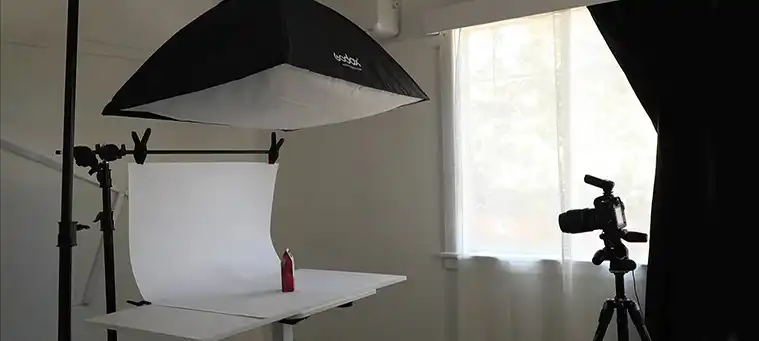Can blurry, pixelated pictures of your products really stand between you and eCommerce success? Absolutely! In a virtual shop, where customers can’t hold, touch, or feel your offerings, high-quality product photography is your silent salesperson, your digital storefront window, and your secret weapon for conversion.
Trust me, high-quality product images make a huge difference in connecting with customers and driving those all-important conversions!
In this post, I’ll be sharing why excellent product photography is so crucial for eCommerce success. I’ll also give tips for taking killer product shots that sell and discuss when it’s worth hiring pros. Read on to learn how to use stellar product images to take your online store to the next level!

What is the Importance of Product Photography for Your Virtual Shop?
Product photography plays a crucial role in eCommerce. High-quality product images can make or break online sales. Here are some of the key reasons why product photography is so important for virtual shops:
It’s the First Impression
In the online world, product photos create that critical first impression. Clear, well-lit, high-resolution photos allow customers to see all the important details of a product before purchasing. This builds trust and confidence in the product quality. Poor quality or misleading photos, on the other hand, create doubt and drive customers away.
It Tells a Story
Great product photography doesn’t just show what an item looks like, it shows what it’s like to own or use it. Lifestyle images and creative compositions allow customers to visualize the product experience and connect on an emotional level. This storytelling quality of product photography is a powerful sales tool.
It Builds Trust and Credibility
Retail websites with professional, consistent product photos convey legitimacy and attention to detail. Customers feel they can rely on the quality of the items shown. Amateurish or inconsistent photos undermine trust, making customers unsure of what to expect if they place an order.
It Boosts Conversions and Sales
According to research, 65% of consumers are more likely to purchase a product if there are multiple product images from different angles. When customers get to see a product from all sides and get a true sense of it visually, it significantly increases conversions and sales.
It Reduces Returns
By providing a comprehensive visual representation of products, professional photography reduces unwelcome surprises upon delivery. Customers get what they expect, avoiding disappointment and minimizing returns or refunds. This saves online retailers significant time and money.
Components of Excellent Product Photography
Now that you’re convinced (I hope!), let’s learn how to take amazing product photos that make people want to buy. For the best eCommerce product photos check all the following boxes:
Clear, Crisp, And Well-Composed Images
Use a high-quality camera with sufficient megapixels and resolution for crisp detail. Choose a low ISO for minimal graininess. Use a tripod for sharpness. Set the aperture appropriately for the desired depth of field. Compose shots to emphasize the product, using principles like the rule of thirds. Leave some negative space around the product to avoid a cluttered look.
Multiple Angles and Close-Ups for Detail
Take photos of the product from straight-on, from above, from the side, from the back, and any other logical angles. Include detailed shots focused on specific parts of the product – for example, buttons, logos, or fabric close-ups for apparel. Shoot alternate views like the product is open or in use. The goal is to thoroughly document the product from all relevant visual perspectives.
Lifestyle Shots Showing the Product in Use
Authentically showcase how customers would use the product. Photograph products in natural environments and contexts, used by people who represent your target demographic. If showing the product worn or handled, ensure real-looking, not staged, interactions. These “lifestyle” shots add storytelling and build product credibility.
Consistent Lighting and Background
For studio shots, use soft box lighting placed at 45-degree angles to avoid shadows. For lifestyle shots, choose lighting that makes sense for the situation depicted. Keep lighting consistent across product images to maintain a cohesive look. Use backdrops and surfaces appropriate for the product that won’t distract or clash. Keep the background stylistically matched across product photos.
Professional Editing for Optimal Presentation
Use photo editing software to make adjustments that optimize the images. Correct color, white balance, and exposure. Sharpen details. Selectively enhance elements. Retouch to remove imperfections, dust, etc. Crop images consistently to focus on the product. Ensure file output quality and formats are appropriate for the intended use.
Increased Click-Through Rates and Add-To-Cart Rates.
Visually appealing product photos pique customer curiosity and make them more likely to click for a closer look or quickly add the product to their cart. Unique angles and close-ups allow you to showcase striking visuals not visible in generic stock photos. Consistent image quality and style also help products stand out clearly. This grabs customer attention in a crowded market.
Higher Conversion Rates and Sales.
With high-quality photos from every angle, customers can inspect a product closely and understand it fully without needing to see it in person. This reduces uncertainty about fit, function, materials, and other attributes. Feeling confident about what they will receive, customers are more willing to complete the purchase. Some may have returned the product if the real version did not match expectations.
Reduced Return Rates and Improved Customer Satisfaction
According to research, 22% of customers end up not buying a product when they don’t get proper pictures of the product they are willing to buy! When product photos accurately reflect sizing, materials, color, and other details, customers receive what they expect from the depiction. This prevents dissatisfaction and reduces return rates compared to not having detailed images. Customers feel more satisfied with their purchases when products match what was advertised.
Stronger Brand Image and Customer Loyalty
A thoughtfully crafted, consistent photo style helps reinforce your desired brand image and values. Customers come to rely on your brand for not just quality products but also quality photos presenting them attractively. This cultivates brand recognition and loyalty. Customers are more likely to repeatedly purchase from brands they trust to deliver a positive customer experience.
Should You Do the Photography by Yourself or Hire a Professional One?
While DIY product photography seems tempting for new eCommerce stores, professional product photography is worth the investment for most online sellers. Unless you already have high proficiency in photography, lighting, and editing, it is very difficult for beginners to achieve the quality, consistency, and artistry of professional product photos.
The expertise of product photographers in compositing, angles, lighting, and editing allows them to showcase products in their best light and appeal to customers. The visual storytelling, brand polish, and sales effectiveness delivered by professional photography far outweigh the cost.
However, outsourcing everything may not work for all budgets. A balanced approach is having professionals handle the most important products while doing DIY photography for simpler or cheaper items. With practice, in-house skills can also be developed over time. The key is understanding the impact of product photography and allocating sufficient resources toward presenting your products in the best way through images.
Maintain Brand Consistency With Thoughtful Photo Editing
In product photography, the post-production editing stage is just as crucial as the shoot itself. Simple touches like color correction, cropping, selective focus, or brightness adjustments can drastically improve how products look and feel to customers.
With a considered brand style in mind, photo editing can also ensure visual consistency across your product catalog. Establish an editing checklist that aligns with your brand guide on factors like:
- Color tone – Warm, cool, saturation level, etc.
- Stylistic filters – B&W, vintage, modern, etc.
- Brand elements – Logos, text, graphics, etc.
- Cropping – Composition, focus, etc.
- Lighting – Brightness, highlights, shadows, etc.
So, if you want to boost your sales conversion, it’s crucial to edit the product pictures in a proper way. It will ensure that the customers get a proper view of the product. Do the edits by yourself, or seek a professional picture editing service provider to provide an outstanding touch!!
Summing Up
I hope this info helps you understand why product photography is such a big deal in ecommerce. Investing in pro photos or improving your own skills here pays off big time. Your product images are your store’s salespeople – so make them count! Let me know if you have any other questions. Thanks for reading, and here’s to selling more with sensational product photos!
